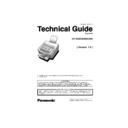Panasonic UF-6300 / UF-6200 / UF-5300 (serv.man3) Service Manual / Other ▷ View online
21
UF-6300/6200/5300
Fuser Temperature Control Circuit Diagram
High Voltage Drive Circuit (Charging, Development and Transfer)
High Voltage is provided through a DC to DC converter, which changes the +24 VDC supply voltage to -
650 VDC, and output approximately 0.64 KVAC (Steady current: 200
650 VDC, and output approximately 0.64 KVAC (Steady current: 200
µA) for the Charging Block. The
Developer Circuit converts the +24 VDC to between -300 VDC for the development bias, and outputs
1,500 VAC (p-p) at a frequency of 1.650 kHz to charge the toner. The Transfer Circuit changes the +24
VDC supply voltage to approximately +280 VDC (MAX) (steady current:3
1,500 VAC (p-p) at a frequency of 1.650 kHz to charge the toner. The Transfer Circuit changes the +24
VDC supply voltage to approximately +280 VDC (MAX) (steady current:3
µA/-1500 VDC steady voltage).
GND
GND
Q44
R394
R399
IC32
R398
GND
R397
R400
C214
R78
+5v
+24V
+3.3V
+3.3V
+3.3V
D26
C263
GND
PC001
1
2
6
4
+24V
R221
Thermistor
PSU (LVPS)
pSSRA
GND
Q43
Q42
79
SC PCB
2
1
CN52
TH2
D25
TH2
11
CN6
11
CN103
(ANI1)
IC1
CPU
R401
R396
R395
IC3
SHINE
22
UF-6300/6200/5300
High Voltage Drive Circuit
1.1.11. Interlock Safety Circuit
This safety circuit turns OFF the +24 VDC supply voltages when the Cover is opened. When the Cover is
opened, the microswitch(es) on the ILS PC Board are de-actuated, turning OFF +24 VDC to the Printer
Drive Circuit, the High Voltage Power Supply, and the Paper Feed Solenoid Circuits, turning OFF the +5
VDC supply voltage for the Laser Driver circuits on the Laser Unit.
opened, the microswitch(es) on the ILS PC Board are de-actuated, turning OFF +24 VDC to the Printer
Drive Circuit, the High Voltage Power Supply, and the Paper Feed Solenoid Circuits, turning OFF the +5
VDC supply voltage for the Laser Driver circuits on the Laser Unit.
GND
Q40
FG
Discharge Plate
Bias Transfer Roller
Bias Charge Roller
Development Roller
Q39
Q38
HVPS
CPU
pCR0
pCR1
pTR0
CN53
3
4
GND
T
C
D
5
SC PCB
Toner
Cartridge
Cartridge
Q41
pDRCK
2
nDRCK
nTR0
nCR1
nCRCK
23
UF-6300/6200/5300
1.1.12 Laser Unit (LSU) Control Circuit
The laser control signals are described below.
nLDEN
The LSU is activated when this output signal is LOW. If an error occurs, the nLDEN output signal level
goes High and the LSU is deactivated.
goes High and the LSU is deactivated.
nVIDEO
This is the actual Data Signal. The Laser is ON when the nVIDEO output signal level is LOW.
nHSYNC
This horizontal synchronization signal transmitted from the Beam Detection Sensor sets the horizontal
position of the laser beam as it crosses the OPC Drum.
position of the laser beam as it crosses the OPC Drum.
nSTART
This is the Scanner Motor Control Signal. The Scanner Motor rotates when the nSTART output signal
level is LOW.
level is LOW.
nREADY
A Phased-Lock Loop (PLL) circuit keeps the Scanner Motor speed constant when the nREADY is at a
Low output signal level.
Low output signal level.
+24V
LVPS
(Power Supply Unit)
+24V
+24V
Cover
+24VD
ILS PCB
Paper Feed Solenoid
Laser Unit
DC/DC
Converter
Rush Current
Protection Circuit
pMPOW
HVPS
(Power Supply Unit)
(Power Supply Unit)
Motor
(SC PCB)
+24VM
+24VM
+24VM
+24VM
L+5V
Interlock Safety Circuit Block Diagram
24
UF-6300/6200/5300
CLK
This is the Scanner Motor Clock.
nS/H
This is the Sample Hold Signal in order to adjust the Laser power. When the Laser switches on
compulsorily, the Laser Power is adjusted to a suitable level and held until the next duty cycle in order to
keep the Laser Power stable.
compulsorily, the Laser Power is adjusted to a suitable level and held until the next duty cycle in order to
keep the Laser Power stable.
Laser Unit Control Circuit Block Diagram
1.1.13 Power Supply Unit (LVPS)
Laser
Timing
Sensor
Scanner
Motor
Laser
Drive
Circuit
Scanner
Motor
Drive
Circuit
IC3
SHINE
nVIDEO
nS/H
nLDON
nHSYNC
nPMON
LSU
+3.3V
Q24
IC34
IC35
C190
R330
C189
Q23
Q21
Q22
+5V
R328
R326
SC PCB
6
1
5
2
3
CN68
CN69
23
20
19
nPMRY
nPMCK
2
1
30
163
24
21
GND
INPUT
INPUT
CIRCUIT
RECTIFIER
CIRCUIT
CIRCUIT
CONVERTER
CIRCUIT
(Q100)
CIRCUIT
(Q100)
+5 VP OUTPUT
-5 VDC OUTPUT
+24 VDC OUTPUT
GND
GND
0
A-B Voltage
C
A
B
D
GND
CONTROL
CIRCUIT
OVER CURRENT
LIMITTER
ERROR DETECTION
CIRCUIT
+5 VDC
OUTPUT
CIRCUIT
CIRCUIT
+5 VP OUTPUT
GND
+5 VP OUTPUT
CIRCUIT
-5 VDC
OUTPUT
CIRCUIT
CIRCUIT
+24 VDC
OUTPUT
CIRCUIT
OUTPUT
CIRCUIT
C103
0
C-D Voltage
0
E-F, G-H Voltage
Click on the first or last page to see other UF-6300 / UF-6200 / UF-5300 (serv.man3) service manuals if exist.

